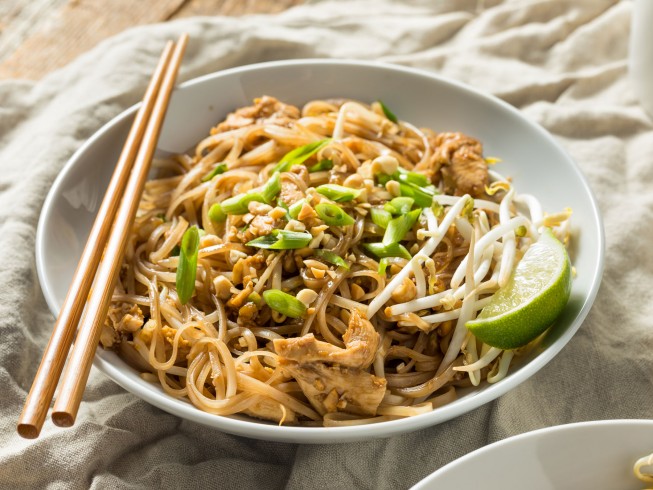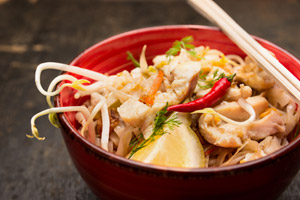It may look like a sad little package shoved in the back of your freezer, but frozen spinach actually has a lot of culinary uses (and some may surprise you).

Imagine sitting at a bustling street market in Southeast Asia while you savor this Pad Thai, featuring tender chicken and an irresistible peanut sauce that's all yours to whip up at home.

Peanut Sauce
2/3 cup evaporated milk
1/3 cup chunky peanut butter
1 tablespoon soy sauce
1/4 teaspoon ground ginger
Pad Thai
8 ounces dried thin rice noodles or linguine (cooked al dente)
1/4 cup water
1/4 cup granulated sugar
2 tablespoons ketchup
1 1/2 tablespoon soy sauce
1 tablespoon fresh lime juice
1/8 teaspoon ground cayenne pepper
2 tablespoons vegetable oil
1 boneless, skinless chicken breast halves, cut into small bite-sized pieces
2 cloves garlic, minced
1 large egg, beaten
2 cups fresh bean sprouts
1 bunch green onions, sliced, divided
1/2 cup chopped peanuts, divided
1 lime, cut into wedges
For the peanut sauce, combine the evaporated milk, peanut butter, soy sauce, and ginger in a bowl and stir until smooth and uniform in color. Set aside.
Place the rice noodles in a heat-proof bowl. Pour very hot water over the noodles. Stir the noodles gently to separate them. Let the noodles sit in the hot water for 20 minutes.
In a small bowl, combine the water, sugar, ketchup, soy sauce, 1 tsp lime juice, and cayenne pepper. Mix well until smooth. Set aside.
Heat the oil in a wok or large non-stick skillet over medium-high heat. Add the chicken and cook, stirring frequently, for 4 minutes or until almost cooked through. Add the garlic and continue to cook for another minute.
Drain the water from the rice noodles and add the noodles to the wok, stirring constantly for 1 minute. Add the ketchup mixture to the wok. Cook, stirring constantly, for 2 minutes or until the sauce is absorbed by the noodles.
Clear some space in the wok by pushing the noodles and chicken to the edges. Add the egg to the middle of the wok and cook, stirring constantly, until the egg is cooked. Add the bean sprouts, half of the green onions, and half of the peanuts to the wok. Stir the noodles and chicken back into the center of the wok and mix with the egg and other ingredients.
To serve, transfer the pad Thai to a serving plate. Drizzle with 1/2 cup of the peanut sauce and the remaining lime juice. Sprinkle with the remaining green onions and peanuts.
Serve with additional lime wedges and the remaining peanut sauce.
Soak rice noodles in hot water until pliable but not completely soft, as they will continue cooking in the skillet.
Use high heat when stir-frying to get the right texture without overcooking the ingredients.
Adjust the sweetness of the sauce by modifying the sugar quantity based on your preference for sweet versus savory.
Garnish with fresh herbs like cilantro or Thai basil.
For a richer flavor, add a splash of fish sauce to the peanut sauce.
Serve Pad Thai with lime wedges to squeeze over the top.
Experiment with different types of proteins or vegetable combinations.
Make sure to have all ingredients prepped and handy since stir-frying happens quickly.
For a creamier peanut sauce, try adding a teaspoon of sesame oil.
Add more lime juice to the peanut sauce if you prefer a tangier flavor.
Pad Thai is a popular Thai stir-fried noodle dish made with rice noodles, proteins like chicken or shrimp, vegetables, and a balance of sweet, sour, and salty flavors.
You can substitute coconut milk for evaporated milk to keep the creamy texture while adding a subtle coconut flavor. Heavy cream or whole milk can also work but will alter the taste.
Chunky peanut butter is recommended for texture, but you can use smooth peanut butter if you prefer a creamier sauce. Natural peanut butter can also be used, but it may separate more during cooking.
Yes, fresh rice noodles can be used. Adjust cooking time accordingly, as they may need to be stir-fried for a shorter period.
Leftovers can be stored in an airtight container in the refrigerator for up to 3 days. It's best to keep the peanut sauce separate until ready to serve.
Reheat it in a skillet over medium heat, adding a splash of water or broth if it seems dry and to help keep it from sticking. Stir frequently.
While the rice noodles can change texture when frozen, you can freeze Pad Thai for up to 1-2 months. Cool completely before transferring to freezer-safe containers. Reheat on the stove, adding a little water to rehydrate the noodles.
You can use shrimp, tofu, or tempeh as a substitute for chicken. For heartier flavor, try using beef or pork.
To adjust the spice level, reduce or omit the cayenne pepper, or add a mild sauce like sriracha or add crushed red pepper flakes to taste.
Feel free to add or substitute other vegetables like bell peppers, carrots, broccoli, or zucchini.
Wine Pairings
Chardonnay: A lightly oaked Chardonnay can be a great match since its smooth, buttery texture complements the creamy peanut sauce, while citrus notes from the wine can brighten the overall dish. Look for one that's not too heavy, with hints of apple and pear.
Gewurztraminer: This wine adds a touch of fruitiness with floral notes, which can match the sweetness of the sauce and the heat from the cayenne. Go for one that has a slightly off-dry taste to balance the flavors in the Pad Thai.
Sauvignon Blanc: A crisp Sauvignon Blanc works well with this dish thanks to its zesty acidity and herbal notes.
Other Alcohol Pairings
Thai Beer: A light Thai beer like Singha or Chang would be refreshing alongside your Pad Thai. The crispness and slight maltiness won't compete with the dish, letting the flavors of the peanut sauce shine.
Vodka Soda: A simple vodka lime soda can be a perfect pairing. It's clean and refreshing, allowing you to enjoy the dish without overwhelming it with complex flavors. The lime in the drink echoes the fresh lime wedges served with the Pad Thai.
Sake: A chilled Junmai sake has a nice balance of umami and sweetness, making it a smooth partner for the creamy peanut sauce. Look for one that is light and not too fragrant.
Non-Alcoholic Pairings
Lemonade: A refreshing homemade lemonade can really connect with the lime in the dish while providing a sweet and tangy counterpoint to the savory and creamy elements of the Pad Thai.
Coconut Water: This keeps things light and adds a slightly sweet flavor that complements the peanuts and balances the spice from the dish.
Pineapple Juice: This fruity choice offers a nice contrast to the creamy peanut sauce and supports the sweetness from the sugar in the recipe.
Wok or Large Non-Stick Skillet: For cooking the chicken and noodles.
Measuring Cups and Spoons: For measuring ingredients such as water, sugar, bean sprouts, and peanuts needed for both the peanut sauce and pad Thai.
Heat-Proof Bowl: Used for soaking the rice noodles in hot water. It should be able to withstand hot temperatures without cracking or breaking.
Mixing Bowls: At least two are needed; one for making the peanut sauce and another for combining the water, sugar, ketchup, and soy sauce mixture.
Spatula or Wooden Spoon: For stirring the chicken, noodles, and other ingredients in the wok.
Chef's Knife: For cutting the boneless chicken breast into bite-sized pieces and slicing the green onions.
Garlic Press or Knife: To mince the garlic cloves.
Whisk or Fork: For beating the egg before adding it to the wok.
Colander or Strainer: For draining the water from the soaked rice noodles before adding them to the wok.
Serving Plate: Used for plating the finished pad Thai for serving.
Lime Juicer (optional): While not absolutely necessary, a lime juicer can help extract juice efficiently.
Chili Garlic Shrimp: The heat from the chili garlic shrimp complements the creamy peanut sauce, creating a dynamic flavor contrast that enhances the overall dish. Replace the chicken in the recipe with it or make it a combo dish and toss the shrimp on top.
Crispy Spring Rolls: These can be served on the side for added crunch; they also provide a fresh and light balance to the richness of the pad thai.
Cucumber Salad: A refreshing cucumber salad with rice vinegar, sugar, and sesame oil can help cut through the richness of the peanut sauce.
Thai Fish Cakes: Their savory flavor and crispy texture can provide a nice counterpoint to the noodles and creamy sauce.
Mango Sticky Rice: For dessert, this traditional Thai dish adds sweetness and texture, finishing the meal with a balance to the savory and nutty flavors of the pad thai.
Chili Sauce: Serving a spicy chili sauce on the side offers diners the option to add heat.
It may look like a sad little package shoved in the back of your freezer, but frozen spinach actually has a lot of culinary uses (and some may surprise you).
In a cooking rut? Try one of these taste-tested, family-approved recipes using ground beef.
Pumpkins aren't just for pies or Halloween decorations. These large, orange gourds - while naturally sweet - also work well in savory dishes. They pair well with poultry and pork (and especially bacon) and their creamy-when-cooked texture blends easily into soups.


Online since 1995, CDKitchen has grown into a large collection of delicious recipes created by home cooks and professional chefs from around the world. We are all about tasty treats, good eats, and fun food. Join our community of 200K+ members - browse for a recipe, submit your own, add a review, or upload a recipe photo.

reviews & comments